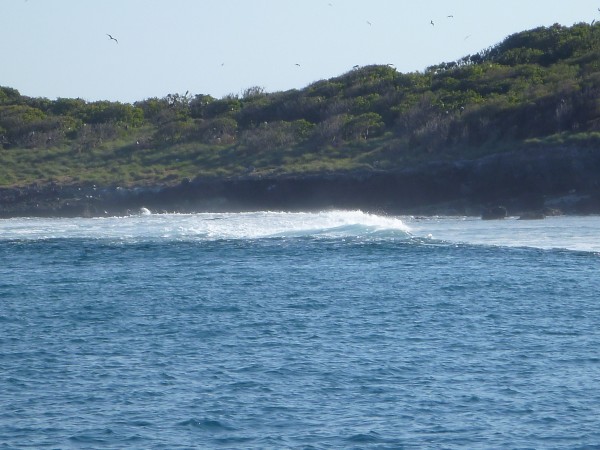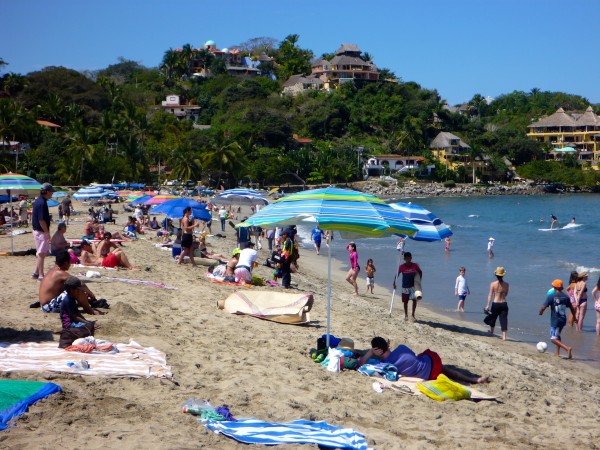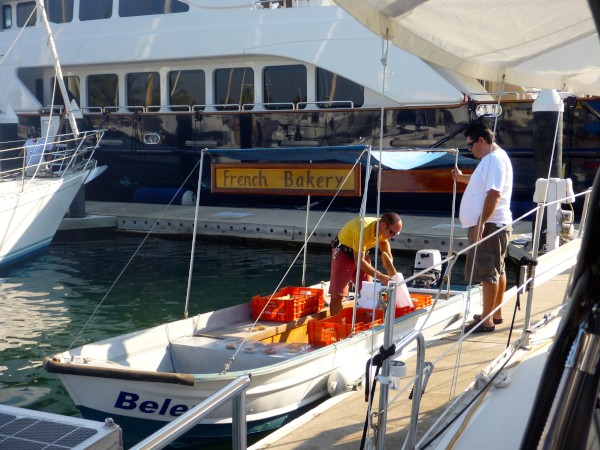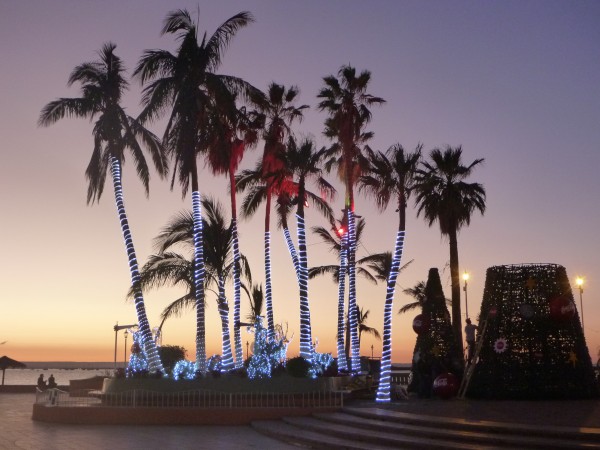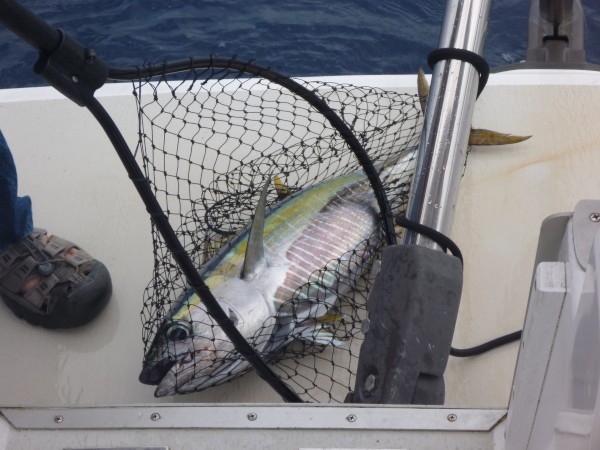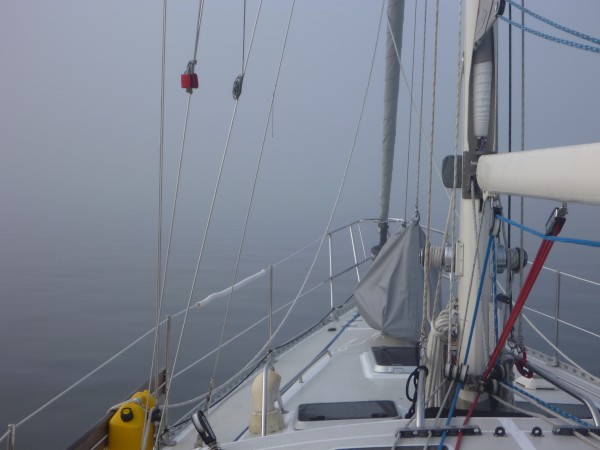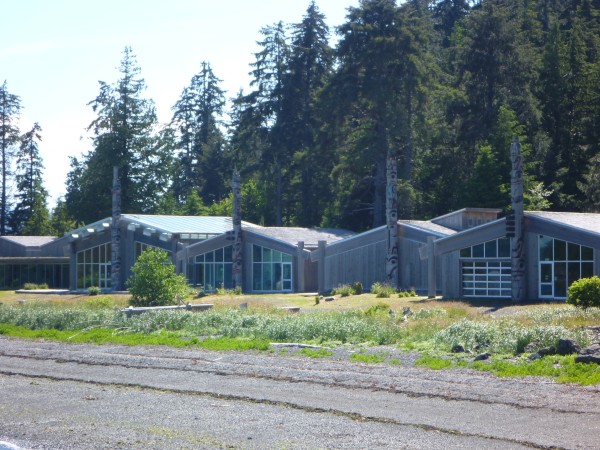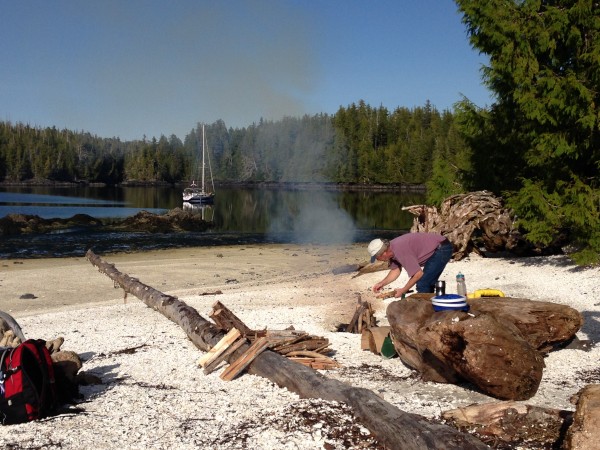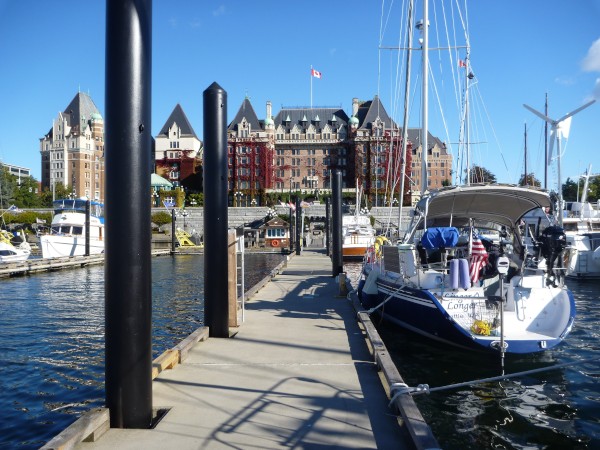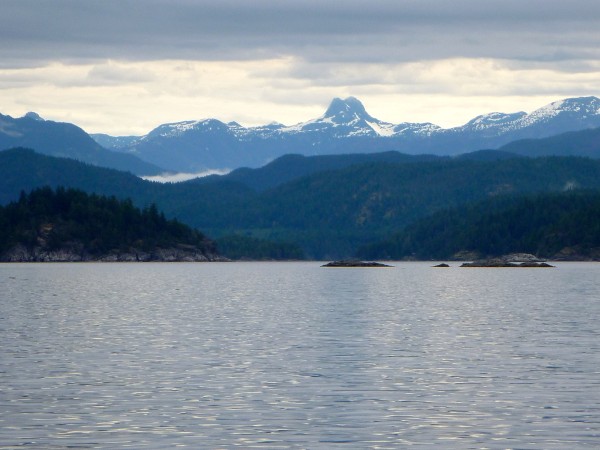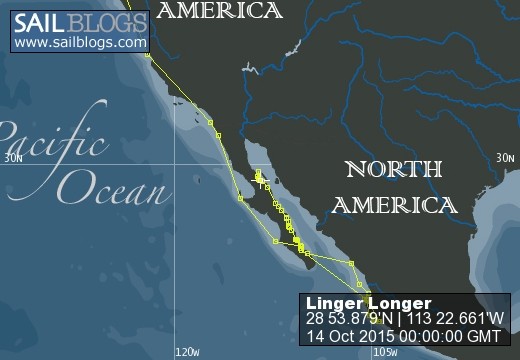
Linger Longer
14 September 2016
06 August 2016
09 July 2016
19 March 2016
19 December 2015
18 December 2015
18 December 2015
03 November 2015
18 July 2015
24 May 2015
04 April 2015
31 March 2015
26 February 2015
15 February 2015 | Barra de Navidad
07 February 2015 | Tenacatita Bay
04 February 2015
26 January 2015 | 19 18.051'N
04 January 2015 | La Cruz, Nayarit, Mexico
25 December 2014 | La Paz, Baja California Sur, Mexico
01 December 2014 | Ensenada, Mexico
Reflections by Kirk
01 December 2014 | Ensenada, Mexico
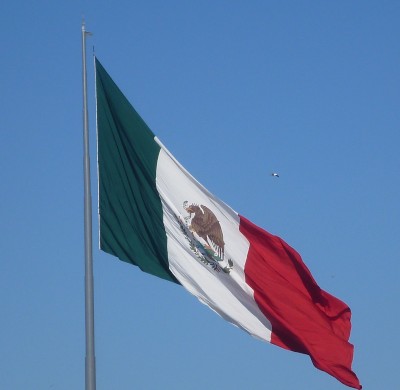
Reflections by Kirk Dec. 1, 2014
It has been awhile since I have added to the reflections and for that I apologize. It seems like we have been in a bit of a rush since then; and although some really great things have happened, I lacked the inspiration to write of them. Hope that I will be getting back on track.
When I last wrote, we were just leaving Alaska and we are now in Ensenada, Mexico. Something in excess of 1,500 nautical miles and three different countries have happened. Our return through British Columbia was highlighted by a voyage out to the Queen Charlotte Islands, which are now known as Haida Quaii. These islands average about one hundred miles into the Pacific Ocean from the British Columbia coastline. They are notable for several reasons. They were spared from being covered by glaciers for well over 10,000 years and that has allowed the Haida culture to survive and eventually flourish for this same period of time. The Haida's claim to be one of the oldest continuing cultures on earth. As you may imagine, one culture living in the same place for over 10,000 years has given them an unparalleled opportunity to figure out how to live in a sustainable manner on their piece of the planet. The islands have also become a unique partnership between government and the people. The Canadian government and the Haida people jointly manage the huge south island for the benefit of the Haida people as well as the general public in the form of a national park, parts of which have been declared a World Heritage site. In a part of the world where woodcarving is acknowledged to be outstanding in general, the Haidas are the best. The return trip to the British Columbia coast also gave Kris and me our first opportunity for an overnight at sea in our own boat.
We also had an opportunity to return to Victoria for a few days to see what Victoria looks like in the summer and to hook up with Matt and Joss, our dock mates for several months. We had met up with several friends from our Yacht Club in Seattle during British Columbia travels and topped it off by being at a club rendezvous at Sucia Island in Washington's San Juan Islands. All through this time, the anxiety was building. The time was growing very short for our voyage all the way down the west coast of the United States. Would we, and the boat, be up to the challenge? We spent about a week in Friday Harbor taking care of some shopping and such, but mostly to try and reinforce our belief that we have done everything we could to be ready for the trip, which several people who have done it described as the roughest water they had ever encountered. On the 26th of August, we left Neah Bay, the extreme west end of the Strait of Juan de Fuca, made a left turn, and were committed. Two nights at sea and we decided to stop at Newport, OR to visit with family. That stop lasted ten days with the visiting and waiting for forecasts of something less than 30 knots of wind and three meter seas. Did I mention that we might be a bit overly cautious? We finally left and hopped our way down the coast arriving at the Harbor Island West Marina in San Diego on the 19th of September.
Wow, what a drastic change of climate. Having spent well over one year in the cool, dampish, sometimes downright wet and cold climate of British Columbia and Alaska, we started to wonder how we would survive the warmth and brilliant sunshine "down south." It really took very little time to discover that we like warmth and sunshine.
So how was the trip down the coast? Let me start by again saying that we might be a little overly cautious. At the time, there were still hurricanes battering or threatening to batter the south end of the Baja Peninsula. These storms were sending swells up from the southwest. These swells were not large, maybe two or three feet and well spaced apart. But combining these with six to nine feet swells from the northwest, spaced much more closely together, could make for a bit of a bumpy ride. The winds were most generally forecast from the northwest. We decided to wait until wind forecasts were below twenty knots before venturing out into the ocean. The only problem was that the wind forecasts were either above 25 knots or below ten, so we ventured out in light winds; and, for us, the biggest seas we have ever been in with just the two of us. The result was a lot of motoring with quite a bit of motion to the boat. Much of the time we did not even have enough wind to hoist the mainsail to try and help steady the boat. We tried, but often times there was not enough wind to keep the sail full. As the boat rolled, the wind would spill from the sail followed by a violent snap as the sail filled up again when we rolled to the other side. This cannot be good for the sails, so we limited the exercise to times when we could keep the sail filled with wind. Of course when there was enough wind to keep the sail full, the resultant wind generated waves on top of the swells made the rolling even rollier. Sleeping in these conditions or at least trying to sleep is an interesting experience. We set up a space in the aft cabin that was ringed by anything soft that we could roll up creating a trough just about as wide as our shoulders. I adopted the method described to me by good friend and long time seagoing tug man, Jack Mulvaney, to lie on my back with legs spread as wide as possible and hands on my chest with elbows at my sides to further limit sideways movement. Thank you Jack. After a few days the need for sleep made it possible to sleep well. It is a law of the sea, and common sense, that someone always needs to be on watch. That means awake and paying attention to things like other ships, changes in weather or the presence of whales directly in our path. Kris and I would stand two hour watches from 1000 (10 AM) until 1800 (6 PM) and then four hour watches through the night. Your sleep cycles get a little weird, but you do get adjusted. Anyway, we made it and the anxiety was really not warranted. There was no sense of danger, just occasional discomfort. It is a really good feeling to have done that trip and the sense of accomplishment is large.
We spent over two months in San Diego, as planned, as the list of repairs and improvements to the boat was now over three pages long. That was just my list. Kris had her own which was nearly as long. So instead of being tourists, soaking up the sunshine and exploring the San Diego area we truly became part of what I have been told cruising is all about, making boat repairs in exotic places. We really did work hard - added a water maker (a magical device that turns seawater into drinking water), a downwind pole, a complete new instrument package (radar, chart plotter, new autopilot) -- the works, the 1,000-hour engine service (which is quite comprehensive), and a myriad of other things to help make our life safer, more comfortable, and more enjoyable. I believe that this was time and money well spent. The boat will probably never be in such good shape again.
We were so busy that the anxiety of entering a country with a different culture, different language, different lots of things did not begin to set in until within a day or two of our departure. But think about it. We are not going on a two-week vacation to a foreign country. We are going to be living there for at least six months, when our current tourist visa expires, and hopefully longer. Different currency, different food, different street signs, different hygiene, don't drink the water, only eat fruits that can be peeled. There will be an awful lot of stuff to adjust to. I am glad that we were so busy that these thoughts did not dwell on me.
Now we are here in Mexico. There is quite a bit of paperwork involved, especially when you are bringing your home with you. That went very smoothly with the assistance of the excellent folks from the marina where we are staying for a few days. During that process we learned the location of THE bar where the marguerita cocktail was invented. After the immigration, customs, boat importation process, this ended up being our very first stop in this new-to-us country. Out the window went all the precautions about drinking the water or ice used to make our cocktails. We have now been stuck on the boat for two days afraid to get too far away from the toilet. Oh well, like I said, there will be a lot of new things to get adjusted to.
Hasta luego.
Kirk
It has been awhile since I have added to the reflections and for that I apologize. It seems like we have been in a bit of a rush since then; and although some really great things have happened, I lacked the inspiration to write of them. Hope that I will be getting back on track.
When I last wrote, we were just leaving Alaska and we are now in Ensenada, Mexico. Something in excess of 1,500 nautical miles and three different countries have happened. Our return through British Columbia was highlighted by a voyage out to the Queen Charlotte Islands, which are now known as Haida Quaii. These islands average about one hundred miles into the Pacific Ocean from the British Columbia coastline. They are notable for several reasons. They were spared from being covered by glaciers for well over 10,000 years and that has allowed the Haida culture to survive and eventually flourish for this same period of time. The Haida's claim to be one of the oldest continuing cultures on earth. As you may imagine, one culture living in the same place for over 10,000 years has given them an unparalleled opportunity to figure out how to live in a sustainable manner on their piece of the planet. The islands have also become a unique partnership between government and the people. The Canadian government and the Haida people jointly manage the huge south island for the benefit of the Haida people as well as the general public in the form of a national park, parts of which have been declared a World Heritage site. In a part of the world where woodcarving is acknowledged to be outstanding in general, the Haidas are the best. The return trip to the British Columbia coast also gave Kris and me our first opportunity for an overnight at sea in our own boat.
We also had an opportunity to return to Victoria for a few days to see what Victoria looks like in the summer and to hook up with Matt and Joss, our dock mates for several months. We had met up with several friends from our Yacht Club in Seattle during British Columbia travels and topped it off by being at a club rendezvous at Sucia Island in Washington's San Juan Islands. All through this time, the anxiety was building. The time was growing very short for our voyage all the way down the west coast of the United States. Would we, and the boat, be up to the challenge? We spent about a week in Friday Harbor taking care of some shopping and such, but mostly to try and reinforce our belief that we have done everything we could to be ready for the trip, which several people who have done it described as the roughest water they had ever encountered. On the 26th of August, we left Neah Bay, the extreme west end of the Strait of Juan de Fuca, made a left turn, and were committed. Two nights at sea and we decided to stop at Newport, OR to visit with family. That stop lasted ten days with the visiting and waiting for forecasts of something less than 30 knots of wind and three meter seas. Did I mention that we might be a bit overly cautious? We finally left and hopped our way down the coast arriving at the Harbor Island West Marina in San Diego on the 19th of September.
Wow, what a drastic change of climate. Having spent well over one year in the cool, dampish, sometimes downright wet and cold climate of British Columbia and Alaska, we started to wonder how we would survive the warmth and brilliant sunshine "down south." It really took very little time to discover that we like warmth and sunshine.
So how was the trip down the coast? Let me start by again saying that we might be a little overly cautious. At the time, there were still hurricanes battering or threatening to batter the south end of the Baja Peninsula. These storms were sending swells up from the southwest. These swells were not large, maybe two or three feet and well spaced apart. But combining these with six to nine feet swells from the northwest, spaced much more closely together, could make for a bit of a bumpy ride. The winds were most generally forecast from the northwest. We decided to wait until wind forecasts were below twenty knots before venturing out into the ocean. The only problem was that the wind forecasts were either above 25 knots or below ten, so we ventured out in light winds; and, for us, the biggest seas we have ever been in with just the two of us. The result was a lot of motoring with quite a bit of motion to the boat. Much of the time we did not even have enough wind to hoist the mainsail to try and help steady the boat. We tried, but often times there was not enough wind to keep the sail full. As the boat rolled, the wind would spill from the sail followed by a violent snap as the sail filled up again when we rolled to the other side. This cannot be good for the sails, so we limited the exercise to times when we could keep the sail filled with wind. Of course when there was enough wind to keep the sail full, the resultant wind generated waves on top of the swells made the rolling even rollier. Sleeping in these conditions or at least trying to sleep is an interesting experience. We set up a space in the aft cabin that was ringed by anything soft that we could roll up creating a trough just about as wide as our shoulders. I adopted the method described to me by good friend and long time seagoing tug man, Jack Mulvaney, to lie on my back with legs spread as wide as possible and hands on my chest with elbows at my sides to further limit sideways movement. Thank you Jack. After a few days the need for sleep made it possible to sleep well. It is a law of the sea, and common sense, that someone always needs to be on watch. That means awake and paying attention to things like other ships, changes in weather or the presence of whales directly in our path. Kris and I would stand two hour watches from 1000 (10 AM) until 1800 (6 PM) and then four hour watches through the night. Your sleep cycles get a little weird, but you do get adjusted. Anyway, we made it and the anxiety was really not warranted. There was no sense of danger, just occasional discomfort. It is a really good feeling to have done that trip and the sense of accomplishment is large.
We spent over two months in San Diego, as planned, as the list of repairs and improvements to the boat was now over three pages long. That was just my list. Kris had her own which was nearly as long. So instead of being tourists, soaking up the sunshine and exploring the San Diego area we truly became part of what I have been told cruising is all about, making boat repairs in exotic places. We really did work hard - added a water maker (a magical device that turns seawater into drinking water), a downwind pole, a complete new instrument package (radar, chart plotter, new autopilot) -- the works, the 1,000-hour engine service (which is quite comprehensive), and a myriad of other things to help make our life safer, more comfortable, and more enjoyable. I believe that this was time and money well spent. The boat will probably never be in such good shape again.
We were so busy that the anxiety of entering a country with a different culture, different language, different lots of things did not begin to set in until within a day or two of our departure. But think about it. We are not going on a two-week vacation to a foreign country. We are going to be living there for at least six months, when our current tourist visa expires, and hopefully longer. Different currency, different food, different street signs, different hygiene, don't drink the water, only eat fruits that can be peeled. There will be an awful lot of stuff to adjust to. I am glad that we were so busy that these thoughts did not dwell on me.
Now we are here in Mexico. There is quite a bit of paperwork involved, especially when you are bringing your home with you. That went very smoothly with the assistance of the excellent folks from the marina where we are staying for a few days. During that process we learned the location of THE bar where the marguerita cocktail was invented. After the immigration, customs, boat importation process, this ended up being our very first stop in this new-to-us country. Out the window went all the precautions about drinking the water or ice used to make our cocktails. We have now been stuck on the boat for two days afraid to get too far away from the toilet. Oh well, like I said, there will be a lot of new things to get adjusted to.
Hasta luego.
Kirk
Comments
| Vessel Name: | S/V Linger Longer |
| Vessel Make/Model: | Sceptre 41/43 |
| Hailing Port: | Seattle, WA |
| Crew: | Kirk & Kristin Doyle |
| Extra: | |
| Home Page: | http://www.k2doyle.com |
S/V Linger Longer's Photos - Main
|
Heading north into the Sea of Cortez for the summer where there is less change of hurricanes.
72 Photos
Created 19 December 2015
|
Who: Kirk & Kristin Doyle
Port: Seattle, WA
